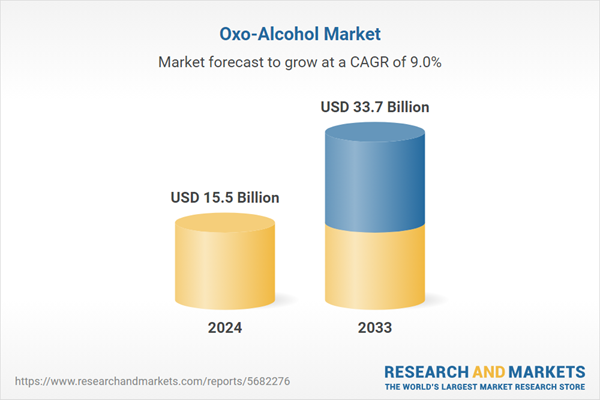Oxo-alcohol is a chemical compound prepared by reacting olefins with syngas at low pressure in the presence of a rhodium catalyst. It includes Isobutanol (IBA), N-Butanol (NBA), and 2-Ethylhexanol (2-EH), which are widely used as solvents and chemical intermediates in manufacturing adhesives, surfactants, paints, coatings, plasticizers, acetates, printing inks, and ethers. Besides this, it finds extensive applications in manufacturing acrylates, which are extensively utilized in the textile, packaging, and automotive industries.
Oxo-Alcohol Market Trends:
Rapid industrialization and the expansion of manufacturing plants are among the key factors catalyzing the demand for oxo-alcohols across the globe. In addition, the growing global population is resulting in rising construction activities, which, in turn, is increasing the need for plasticizers formulated with oxo-alcohols. Apart from this, oxo-alcohols are extensively used in preparing polyvinyl chloride (PVC) products, which are further employed in different industry verticals on account of their enhanced versatility, flexibility, and durability. For instance, it is employed in the cosmetics industry to formulate fragrances, skincare, and hair care products.Additionally, the growing demand for high-quality lubrication systems in the automotive industry is positively influencing the market. Oxo-alcohols are used as dispersants and synthesis intermediates to synthesize lubricants for machinery and automobiles. Besides this, the widespread adoption of oxo-alcohols in synthesizing coatings to prevent blushing when drying in humid conditions and improve flow, gloss, and resistance is strengthening the market growth. The rising use of these chemicals in the pharmaceutical and agricultural sectors is driving the market.
Furthermore, the increasing applications of 2-Ethylhexanol as feedstock on account of its flexibility, lower emissions, good adhesion, and fuel performance enhancement properties are stimulating the market growth. Moreover, rising funds by leading market players in research and development (R&D) activities to introduce more efficient variants of oxo-alcohols, are anticipated to propel the market growth.
Key Market Segmentation:
The research provides an analysis of the key trends in each sub-segment of the global oxo-alcohol market report, along with forecasts at the global and regional level from 2025-2033. Our report has categorized the market based on type.Breakup by Type:
- 2-Ethylhexanol
- n-Butanol
- iso-Butanol
Regional Insights:
- Asia
- North America
- Western Europe
- Others
Competitive Landscape:
The competitive landscape of the industry has also been examined along with the profiles of the key players being China Petrochemical Corporation, OQ Chemicals GmbH (OQ SAOC), LG Chem, BASF SE, Eastman Chemical Company, Formosa Plastics Corporation and Sasol Limited.Key Questions Answered in This Report
- What was the global oxo-alcohol market size in 2024?
- What will be the global oxo-alcohol market outlook during the forecast period 2025-2033?
- What is the impact of COVID-19 on the global oxo-alcohol market?
- What are the major global oxo-alcohol market drivers?
- What are the major global oxo-alcohol market trends?
- What is the global oxo-alcohol market breakup by type?
- What are the major regional markets in the global oxo-alcohol industry?
- Who are the leading players in the global oxo-alcohol industry?
Table of Contents
Companies Mentioned
- China Petrochemical Corporation
- OQ Chemicals GmbH (OQ SAOC)
- LG Chem
- BASF SE
- Eastman Chemical Company
- Formosa Plastics Corporation
- Sasol Limited
Table Information
| Report Attribute | Details |
|---|---|
| No. of Pages | 137 |
| Published | June 2025 |
| Forecast Period | 2024 - 2033 |
| Estimated Market Value ( USD | $ 15.5 Billion |
| Forecasted Market Value ( USD | $ 33.7 Billion |
| Compound Annual Growth Rate | 9.0% |
| Regions Covered | Global |
| No. of Companies Mentioned | 7 |









